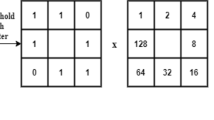Abstract
Texture is one of the most significant characteristics of an image for retrieving visually similar patterns. So far, researchers utilize large number of gray scale features and several combinations of training and testing. As a result, they do not guarantee high accuracy due to mismatch between gray scale features and classifier type. With a view to develop a highly accurate system, the paper proposes a new approach using Binary Dragon Fly with Deep Neural Network based fitness function for texture classification (BDADNN). Contributions of the proposed BDADNN is twofold, first fusion of Fractal, GLCM and GLRLM features has been performed to incorporate border complexities as well as spatial dependencies of a texture image, then Binary Dragon fly Algorithm is applied for feature selection with a novel fitness function based on Deep Neural Network (DNN).The proposed fitness function is designed such a way that it captures maximum accuracy, relevance and mainly minimizing number of features and reduction among features. Deep Neural Network is utilized as a stack of auto encoders. Adapting five types of k-cross-validation (k \(=\) 2,3,4,5,6 and 10) protocols, we classify the texture images using BDADNN. Our results demonstrate superior performance of proposed BDADNN compared to SVM, for all cross-validation protocols (K2, K3, K4, K5 and K10) in terms of sensitivity, specificity and accuracy.








Similar content being viewed by others
References
Mandelbrot, B. B. (1982). The fractal geometry of nature. New York: W.H. Freeman.
Rangayyan, R. M., & Nguyen, T. M. (2007). Fractal analysis of contours of breast masses in mammograms. Journal of Digital Imaging, 20(3), 223–237.
Pavloviov, J., Oravec, M., & Osadsk, M. (2010). An application of gabor filters for texture classification. 23–26.
Campisi, P., Neri, A., Panci, G., & Scarano, G. (2004). Robust rotation-invariant texture classification. IEEE Transactions on Image Processing, 13(6), 782–791.
Randen, T., & Husoy, J. H. (1999). Filtering for texture classification—a comparative study. IEEE Transactions on Pattern Analysis and Machine Intelligence, 21(4), 291–310.
Shang, Z., & Li, M. (2016). Combined feature extraction and selection in texture analysis. In 2016 9th international symposium on computational intelligence and design (vol. 1, pp. 398-401).
Chandrashekar, Girish, & Sahin, Ferat. (2014). A survey on feature selection methods. Computers & Electrical Engineering, 14(1), 16–28.
Molina, L. C., Belanche, L., & Nebot, A. (2002). Feature selection algorithms: A survey and experimental evaluation. In 2002 proceedings on IEEE international conference on data mining.
Yunfei Li, Lu, Zhaoyang, Jing Li, & Deng, Yanzi. (2018). Improving deep learning feature with facial texture feature for face recognition. Wireless Personal Communications, 103, 1–12.
Chang, E. I., Lippmann, R. P., & Tong, D. W. (1990). Using genetic algorithms to select and create features for pattern classification. International Joint Conference on Neural Networks, 3, 747–752.
Vafaie, H., & De Jong, K. (1992). Genetic algorithms as a tool for feature selection in machine learning. In Proceedings fourth international conference on tools with artificial intelligence TAI ’92.
Yang, C. S., Chuang, L. Y., Ke, C. H., & Yang, C. H. (2008). IEEE congress on evolutionary computation: Boolean binary particle swarm optimization for feature selection (pp. 2093–2098).
Zhang, Chunkai, & Hong, Hu. (2005). Using PSO algorithm to evolve an optimum input subset for a SVM in time series forecasting. IEEE International Conference on Systems, Man and Cybernetics, 4, 3793–3796.
Wang, S., & Lam, C. (1996). Texture feature extraction using gray level gradient based co-occurence matrix. 1, 267–271.
Haralick, R. M., Shanmugam, K., & Dinstein, I. H. (1973). Textural features for image classification. IEEE Transactions on Systems, Man and Cybernetics, 3(6), 610–621.
Chen, Yan Qiu, Nixon, Mark S., & Thomas, David W. (1995). Statistical geometrical features for texture classification. Pattern Recognition, 28(4), 537–552.
Man, K. F., Tang, K. S., & Kwong, S. (1996). Genetic algorithms: Concepts and applications [in engineering design]. IEEE Transactions on Industrial Electronics, 43(5), 519–534.
Kennedy, J., & Eberhart, R. C. (1995). Particle swarm optimization. In Proceeding IEEE international conference of neural network IV. Piscataway: IEEE Service centre.
Geem, Zong Woo, Kim, Joong Hoon, & Loganathan, G. V. (2001). A new heuristic optimization algorithm: Harmony search. Simulation, 76(2), 60–68.
Kirkpatrick, S., Gelatt, C. D., & Vecchi, M. P. (1983). Optimization by simulated annealing. Science, 220(4598), 671–680.
Dorigo, M., Maniezzo, V., & Colorni, A. (1996). Ant system: Optimization by a colony of cooperating agents. IEEE Transactions on Systems, Man, and Cybernetics, Part B: Cybernetics, 26(1), 29–41.
Costa, A. F., Humpire Mamani, G., & Traina, A. (2012). An efficient algorithm for fractal analysis of textures (pp. 39-46).
Liao, P., Chen, T., & Chung, P. (2001). A fast algorithm for multilevel thresholding. Journal of Information Science and Engineering, 17(5), 713–727.
Mirjalili, Seyedali. (2016). Dragonfly algorithm: A new meta-heuristic optimization technique for solving single-objective, discrete, and multi-objective problems. Neural Computing and Applications, 27(4), 1053–1073.
Dixit, A., & Hegde, N. P. (2013). Image texture analysis—survey. In Third international conference on advanced computing and communication technologies (ACCT) (pp. 69-76).
Rathore, S., Iftikhar, M. A., Hussain, M., & Jalil, A. (2011). Texture analysis for liver segmentation and classification: A survey. In Frontiers of information technology (pp. 121-126).
Kolkur, S., & Kalbande, D. R. (2016). Survey of texture based feature extraction for skin disease detection. In International conference on ICT in business industry & government (ICTBIG) (pp. 1–6).
Datta, R., Joshi, D., Li, J., & Wang, J. Z. (2008). Image retrieval: Ideas, influences, and trends of the new age. ACM Computing Surveys, 40(2), 1–60.
Author information
Authors and Affiliations
Corresponding author
Additional information
Publisher's Note
Springer Nature remains neutral with regard to jurisdictional claims in published maps and institutional affiliations.
Rights and permissions
About this article
Cite this article
Chatra, K., Kuppili, V. & Edla, D.R. Texture Image Classification Using Deep Neural Network and Binary Dragon Fly Optimization with a Novel Fitness Function. Wireless Pers Commun 108, 1513–1528 (2019). https://doi.org/10.1007/s11277-019-06482-z
Published:
Issue Date:
DOI: https://doi.org/10.1007/s11277-019-06482-z




